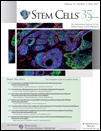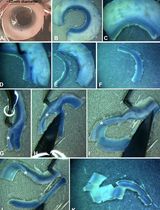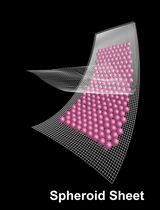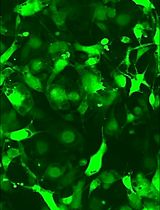- EN - English
- CN - 中文
A Co-culture Assay to Determine Efficacy of TNF-α Suppression by Biomechanically Induced Human Bone Marrow Mesenchymal Stem Cells
人骨髓间充质干细胞共培养实验测定生物力学诱导的TNF-α抑制功效
发布: 2017年08月20日第7卷第16期 DOI: 10.21769/BioProtoc.2513 浏览次数: 9595
评审: Meenal SinhaAnonymous reviewer(s)
Abstract
The beneficial effects of mesenchymal stem cell (MSC)-based cellular therapies are believed to be mediated primarily by the ability of MSCs to suppress inflammation associated with chronic or acute injury, infection, autoimmunity, and graft-versus-host disease. To specifically address the effects of frictional force caused by blood flow, or wall shear stress (WSS), on human MSC immunomodulatory function, we have utilized microfluidics to model WSS at the luminal wall of arteries. Anti-inflammatory potency of MSCs was subsequently quantified via measurement of TNF-α production by activated murine splenocytes in co-culture assays. The TNF-α suppression assay serves as a reproducible platform for functional assessment of MSC potency and demonstrates predictive value as a surrogate assay for MSC therapeutic efficacy.
Keywords: Biomechanical force (生物机械力)Background
Immunomodulatory activity of mesenchymal stem cells (MSCs) is mediated by direct cellular interactions and paracrine factors (Singer and Caplan, 2011; English, 2013). MSCs are believed to originate from pericytes that associate with endothelial cells of vasculature within the bone marrow and various tissues (Sacchetti et al., 2007; Crisan et al., 2008). This unique perivascular location positions them in close proximity to inflammatory and other soluble factors in the blood stream, poising them to monitor systemic signals. Indeed, recruitment of mural cells to the endothelium is a key event in vessel maturation, and pericytes play a critical role in vascular maintenance and integrity (Benjamin et al., 1998; Schrimpf et al., 2014). Pericytes likely monitor systemic signals by fluid outflow from arterioles and capillaries through interendothelial clefts or gaps in the basement membrane, which can expose the basolateral surface of endothelial cells outside the vessel to considerable fluid frictional force, or wall shear stress (WSS), that approximates intraluminal forces (Scallan et al., 2010). MSCs and other classes of pericytes might also view the intraluminal environment from openings between vascular endothelial cells by protrusion into the vascular lumen with cytoplasmic projections much like megakaryocytes, though more typically they ensheathe the blood vessel with branching processes (Shepro and Morel, 1993; Murphy et al., 2013). In instances of inflammation or injury, for example due to trauma to the central nervous system, pericytes have been shown to migrate away from microvessels concurrent with perivascular edema and toward injured tissue in association with blood vessel sprouting (Dore-Duffy et al., 2000; Göritz et al., 2011). Cells described as having features of MSCs have been detected circulating in human peripheral blood (Zvaifler et al., 2000), though there is some controversy surrounding evidence for MSCs in the circulation of healthy and even injured individuals (Hoogduijn et al., 2014). In those cases, disruption of endothelial-pericyte interactions could be expected to exacerbate vascular hyperpermeability which could impact migration or intravasation of MSCs (Mills et al., 2013). As MSCs are anchorage-dependent cells, a likely means of motility would include attachment to the vessel wall resulting in direct exposure to intraluminal WSS. In therapeutic applications wherein MSCs are administered intravenously, WSS would be an unavoidable stimulus during handling, infusion, and trafficking (Nitzsche et al., 2017).
We have shown that WSS typical of arterial blood flow promotes signaling through focal adhesion kinase (FAK), NF-κB, and COX2 (Diaz et al., 2017; Lee et al., 2017). Increased COX2 results in elevated prostaglandin E2 (PGE2) biosynthesis. PGE2 secreted by MSCs plays a central role in regulation of innate and adaptive immune cells. Thus, MSCs exposed to WSS more potently suppress immune cell activation in the presence of inflammatory cues (Diaz et al., 2017; Lee et al., 2017). To quantify MSC immunomodulatory activity in cells exposed to fluid flow, we co-cultured MSCs and lipopolysaccharide-activated murine splenocytes in an adaptation of the commonly used mixed lymphocyte reaction (Plumas et al., 2005). TNF-α was measured by species specific ELISA to determine cytokine production from activated murine splenocytes, thus restricting analysis to immune cell activity and enabling separate determinations of cytokine production by human MSCs. Employing this assay as a surrogate measure of MSC potency, we determined that transient exposure of MSCs to fluid shear stress improved their ability to limit activation of immune cells in the presence of inflammatory stimulus. Preconditioning of MSCs by as little as 3 h of WSS in culture was an effective means of enhancing therapeutic efficacy in treatment of a rat traumatic brain injury model. These data demonstrate that WSS enhances the immunomodulatory and neuroprotective function of MSCs. Together with complementary studies implicating PGE2 as a potency marker of MSC therapeutic efficacy (Kota et al., 2017), our studies suggest that mechanotransduction could be leveraged to improve cellular therapies available for patients with neurological injury. This co-culture assay could easily be adapted for analysis of anti-inflammatory potency of MSCs subjected to a variety of treatments, including genetically engineered MSCs.
Materials and Reagents
- Falcon culture treated flask, 225 cm2 (Corning, Falcon®, catalog number: 353139 )
- Falcon 15 ml conical centrifuge tubes (Corning, Falcon®, catalog number: 352097 )
- 5 ml serological pipettes (MIDSCI, catalog number: MWB-5 )
- Fisherbrand premium microcentrifuge tubes, 1.5 ml (Fisher Scientific, catalog number: 05-408-129 )
- IBIDI µ-Slide VI0.4 ibiTreat, sterile slide (IBIDI, catalog number: 80606 )
- Fisherbrand P200 Low Retention Aerosol Barrier pipet tips (Fisher Scientific, catalog number: 02-717-165 )
- Falcon Petri Dish 150 x 15 mm (Corning, Falcon®, catalog number: 351058 )
- Greiner Petri Dish 35 x 10 mm (Greiner Bio One International, catalog number: 627161 )
- 3-Stop silicone tubing, 1.52 mm I.D. (Cole-Parmer, catalog number: SK-07624-36 )
- Elbow luer connector (IBIDI, catalog number: 10802 )
- Falcon round bottom polypropylene tubes (Corning, Falcon®, catalog number: 352006 )
- EASYStrainer, 70 μm cell sieve, sterile (Phenix Research Products, catalog number: TCG-542070 )
- Falcon 50 ml conical centrifuge tubes (Corning, Falcon®, catalog number: 352098 )
- 1 cc tuberculin syringe plunger
- SHARP P1000 Precision Barrier pipet tips (Denville Scientific, catalog number: P1126 )
- EASYStrainer, 40 μm cell sieve, sterile (Phenix Research Products, catalog number: TCG-542040 )
- 10 ml serological pipettes (MIDSCI, catalog number: MWB-10 )
- Fisherbrand Borosilicate glass Pasteur pipettes (Fisher Scientific, catalog number: 13-678-20C )
- Paper towel
- EMD-Millipore Stericup vacuum filter unit, 500 ml size (EMD Millipore, catalog number: SCGPU05RE )
- Parafilm MTM (Bemis, catalog number: PM996 )
- Dow Corning silastic laboratory tubing 1.57 mm I.D. x 3.18 mm O.D. (Dow Corning, catalog number: 2415569 )
- Human bone marrow (BM) MSC (Whole Bone Marrow aspirates) (AllCells, catalog number: ABM001-0 ) MSCs were isolated from whole bone marrow using a Ficoll gradient followed by plastic adherence and then cultured in MSC media (see Recipes)
Note: The MSCs used for this work were prescreened for the presence of typical MSC growth, appearance and surface marker expression and expanded for stock cyro-preservation prior to its use (Sekiya et al., 2002; Dominici et al., 2006). - Male C57BL/6 mouse (THE JACKSON LABORATORY, catalog number: 000664 ); recommended age between 2-4 months old
- Hyclone Dulbecco’s phosphate buffered saline (DPBS) solution, 500 ml, calcium magnesium free (GE Healthcare, HycloneTM, catalog number: SH30028.FS )
- Gibco-Tryp-LE Express enzyme, 1x, 500 ml (Thermo Fisher Scientific, GibcoTM, catalog number: 12604021 )
- Gibco-trypan blue solution, 0.4% (Thermo Fisher Scientific, GibcoTM, catalog number: 15250061 )
- Atlanta Biological fetal bovine serum (FBS), embryonic stem cell qualified, 500 ml (Atlanta Biologicals, catalog number: S10250 )
- Red blood cell lysing buffer hybri-max (Sigma-Aldrich, catalog number: R7767-100ML )
- Lipopolysaccharide, BioXtra (Sigma-Aldrich, catalog number: L6529 )
- R&D Systems Mouse TNF-alpha Quantikine ELISA kit (R&D Systems, catalog number: MTA00B )
- Hyclone MEM alpha modification with glutamine and nucleosides media (GE Healthcare, HycloneTM, catalog number: SH30265.FS )
- Gibco Penicillin-streptomycin, 10,000 U/ml (Thermo Fisher Scientific, GibcoTM, catalog number: 15140122 )
- MSC media (see Recipes)
Equipment
- Hettich Rotofix 32A with swing bucket for 15 ml and 50 ml conical tubes (Hettich Lab Technology, model: Rotofix 32A )
- Sterile Hood with vacuum suction (The Baker Company, model: SterilGARD® III Advance)
- Hausser Scientific Bright-LineTM counting chamber with cover glass (Hausser Scientific, catalog number: 3110V )
- P2-20 XL3000i pipettor (Denville Scientific, catalog number: P3950-20A )
Note: This product has been discontinued. - P20-200 XL3000i pipettor (Denville Scientific, catalog number: P3950-200A )
Note: This product has been discontinued. - P100-1000 XL3000i pipettor (Denville Scientific, catalog number: P3950-1000A )
Note: This product has been discontinued. - Sanyo CO2 incubator (SANYO, model: MCO-18AIC )
- Ismatec REGLO peristaltic 12 roller pump (Cole-Parmer, catalog number: ISM796B )
- Hettich Mikro 200R refrigerated microcentrifuge (Hettich Lab Technology, model: MIKRO 200R )
- Colorimetric microplate reader (Molecular Devices, model: SpectraMax M2 )
Note: This product has been discontinued. - 37 °C water bath (Fisher Scientific, model: Model 210 , catalog number: 15-462-10Q)
Note: This product has been discontinued.
Procedure
文章信息
版权信息
© 2017 The Authors; exclusive licensee Bio-protocol LLC.
如何引用
Diaz, M. F., Evans, S. M., Olson, S. D., Cox, C. S. and Wenzel, P. L. (2017). A Co-culture Assay to Determine Efficacy of TNF-α Suppression by Biomechanically Induced Human Bone Marrow Mesenchymal Stem Cells. Bio-protocol 7(16): e2513. DOI: 10.21769/BioProtoc.2513.
分类
干细胞 > 成体干细胞 > 间充质干细胞
细胞生物学 > 基于细胞的分析方法 > 炎症反应
您对这篇实验方法有问题吗?
在此处发布您的问题,我们将邀请本文作者来回答。同时,我们会将您的问题发布到Bio-protocol Exchange,以便寻求社区成员的帮助。
Share
Bluesky
X
Copy link

















